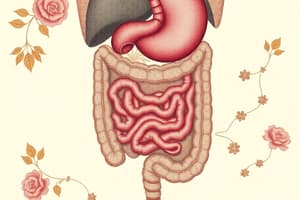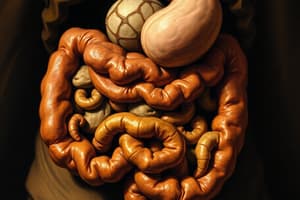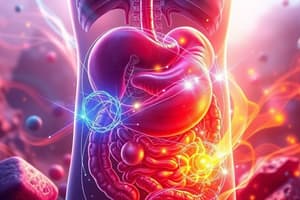Podcast
Questions and Answers
What is the primary function of the small intestine?
What is the primary function of the small intestine?
- Water absorption
- Storage of waste
- Digestion and absorption into the bloodstream (correct)
- Production of bile
The pancreas only secretes bile to aid digestion.
The pancreas only secretes bile to aid digestion.
False (B)
Name the three major parts of the small intestine.
Name the three major parts of the small intestine.
duodenum, jejunum, ileum
The ________ is responsible for producing insulin.
The ________ is responsible for producing insulin.
Match the following organs to their functions:
Match the following organs to their functions:
Which part of the digestive system connects the mouth to the stomach?
Which part of the digestive system connects the mouth to the stomach?
Chemical digestion does not take place in the stomach.
Chemical digestion does not take place in the stomach.
What is the name of the mass of food that is formed in the mouth before it moves down the digestive tract?
What is the name of the mass of food that is formed in the mouth before it moves down the digestive tract?
The _______ sphincter prevents the reflux of food from the stomach to the esophagus.
The _______ sphincter prevents the reflux of food from the stomach to the esophagus.
Which enzyme produced by salivary glands helps in the digestion of starch?
Which enzyme produced by salivary glands helps in the digestion of starch?
Match the following digestive parts with their functions:
Match the following digestive parts with their functions:
The term 'chyme' refers to the bolus of food formed in the mouth.
The term 'chyme' refers to the bolus of food formed in the mouth.
Peristalsis is a ____________ contraction that moves the bolus down the esophagus.
Peristalsis is a ____________ contraction that moves the bolus down the esophagus.
Flashcards
Small Intestine
Small Intestine
The main site where food is broken down into smaller molecules that can be absorbed into the bloodstream.
Bile
Bile
A fluid produced by the liver that helps break down fats into smaller molecules.
Pancreas
Pancreas
An organ that produces digestive enzymes and insulin, important for regulating blood sugar levels.
Insulin
Insulin
Signup and view all the flashcards
Large Intestine
Large Intestine
Signup and view all the flashcards
Digestive System
Digestive System
Signup and view all the flashcards
Digestive Tract
Digestive Tract
Signup and view all the flashcards
Mechanical Digestion
Mechanical Digestion
Signup and view all the flashcards
Chemical Digestion
Chemical Digestion
Signup and view all the flashcards
Esophagus
Esophagus
Signup and view all the flashcards
Cardiac Sphincter
Cardiac Sphincter
Signup and view all the flashcards
Peristalsis
Peristalsis
Signup and view all the flashcards
Stomach
Stomach
Signup and view all the flashcards
Study Notes
Digestive System Overview
- The digestive system is an organ system responsible for taking in food, digesting it, absorbing nutrients, and excreting waste
- It comprises the digestive tract and accessory organs
- The digestive tract includes the mouth, esophagus, stomach, small intestine, and large intestine
Digestive Tract
- The digestive tract forms a continuous pathway
- Food moves through the tract in a unidirectional manner
- Digestion is achieved through mechanical and chemical processes
Mechanical Digestion
- Mechanical digestion involves physically breaking down food into smaller pieces
- Includes actions like chewing (in the mouth) and churning (in the stomach)
Chemical Digestion
- Chemical digestion involves breaking down food into simpler molecules using enzymes and chemicals
- Happens in the mouth (saliva) and stomach (acids and enzymes) to the small intestine
Oral Cavity (Mouth)
- Teeth (incisors, canines, premolars, molars): used for tearing, grinding, and crushing food
- Tongue: manipulates food during chewing, pushing food back to the molars
- Salivary glands: produce amylase, an enzyme which breaks down starch and moistens food
- Resulting food mass is called a bolus
Esophagus
- A muscular tube connecting the mouth to the stomach
- 2 cm in diameter
- The cardiac sphincter is the connection point between the esophagus and the stomach
- Peristalsis, muscle contractions, moves the bolus through the esophagus and into the stomach
Stomach
- J-shaped organ used to store and digest food
- Mechanical digestion: smooth muscles churn bolus into chyme
- Chemical digestion: digestive juices (enzymes and acids) break down food molecules
- Chyme is released into the small intestine through the pyloric sphincter
Small Intestine
- Major site for digestion and absorption of nutrients into the bloodstream
- Three parts: duodenum, jejunum, ileum
- Approximately 6 meters long
Accessory Organs
- Organs that play a supporting or supplementary role in the digestive process
- Includes the liver, gallbladder, and pancreas
Liver
- Organ that produces bile
- Bile helps break down fats into smaller molecules
- Bile is released into the duodenum
Gallbladder
- Stores bile produced by the liver
- Releases bile into the small intestine to aid digestion
Pancreas
- Secretes pancreatic juice containing digestive enzymes
- Breaks down carbohydrates, proteins, and fats
- Also produces insulin, which regulates blood glucose levels
Large Intestine
- Absorbs water and vitamins from undigested matter
- About 1.5 meters long but wider than the small intestine
- Stores undigested matter and toxins in the rectum
- Excretes waste in the form of feces through the anus.
Studying That Suits You
Use AI to generate personalized quizzes and flashcards to suit your learning preferences.
Related Documents
Description
This quiz covers the key aspects of the digestive system, including the structure and function of the digestive tract and the processes involved in mechanical and chemical digestion. You'll explore how food is processed from ingestion to waste excretion. Test your knowledge on the organs involved and their roles in digestion.




